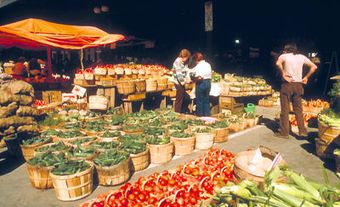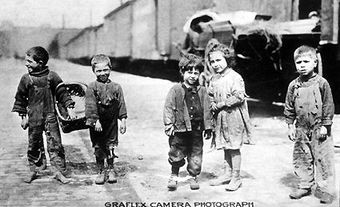Household food insecurity— the inadequate or insecure access to food due to financial constraints — is a serious public health problem in Canada. In 2017–18, 1 in 8 households were food insecure. This amounted to over 4.4 million Canadians. Of that number,
1.2 million were children under 18 years. While food banks are a well-known public response to food insecurity, most food insecure households do not use food banks and there is no evidence that food charity is a durable solution. There is wide consensus
that governments need to act on food insecurity through income-based interventions.
History of the Problem
Our awareness of food insecurity as a problem in Canada dates back to the early 1980s, a time of economic recession when communities across the country noted that people in their midst were going hungry. Charitable food assistance programs were established in response. These programs took the form of food banks, community organizations established to collect donated foodstuffs and redistribute them to those in need. Although initially intended as a temporary emergency response, food banks rapidly grew in number as did the number of people using their services.
Measuring Food Insecurity
The growth of food charities led researchers and policy makers to seek country-wide and representative measures of the number of Canadians experiencing food insecurity. Although national surveys as early as 1994 and 1996 asked questions about hunger and food insecurity respectively, it was not until 2004 that Canada adopted a standardized, validated questionnaire, the Household Food Security Survey Module. Since then, regular population monitoring has occurred through the Canadian Community Health Survey.
The Household Food Security Survey Module used by Canada was originally developed by the U.S. Department of Agriculture . It comprises 18 questions capturing experiences over the past 12 months. These range in severity from worry about running out of food, compromises in food quality, reductions in the amount of food consumed, being hungry, and finally, going a whole day without eating, all because of financial constraints. The questions ask separately about the experiences of adults and children. Based on survey module answers, food secure households are those who report no income-related problem of food access. Marginally food insecure households report some concern or problem of food access over the past 12 months. Households classified as moderately food insecure report compromises in the quality and/or quantity of food consumed among adults and/or children. Finally, households classified as severely food insecure report serious food access problems including reduced food intake among adults and/or children because of a lack of money for food.
The most recent information on the extent of the problem of food insecurity in Canada comes from the 2017–18 Canadian Community Health Survey. According to the survey, 12.7 per cent of households were food insecure, including 4.0 per cent marginally food insecure, 5.7 per cent moderately food insecure, and 3.0 per cent severely food insecure. These household percentages translate to 4.4 million Canadians living in food insecure households. This is likely an underestimate of the true number because the survey excludes some highly vulnerable groups such as First Nations peoples living on-reserve and homeless people.
Who Experiences Food Insecurity in Canada
Food insecurity is a serious problem across the country, but the rate is much, much higher in Nunavut than elsewhere. In 2017–18, 57.0 per cent of households in Nunavut were food insecure and 23.7 per cent experienced severe food insecurity. Rates of food insecurity were also somewhat higher in the other territories and Maritime provinces compared with central and western Canada. However, in no province or territory in Canada does the prevalence of food insecurity fall below 1 in 10 households.

Prevalence of household food insecurity in Canada, 2017-18.
Graphic: PROOF, Food Insecurity Policy Research.
The profile of food-insecure households in Canada in 2017–18 highlights the relationship between food insecurity and problems of social and economic disadvantage. Those most at risk are households with low incomes and limited assets such as those who rent rather than own their own homes. Indigenous and Black households are disproportionately impacted by food insecurity, as are families with children, and households reliant on social assistance, Employment Insurance or Workers’ Compensation. While the risks are higher for households receiving income support, about two-thirds of food-insecure households report that their main source of income is from work. Since monitoring began, the profile of food insecure households has changed little and the numbers have tended to rise.
Food Insecurity is an Income Problem
Food insecurity is about more than not having enough food. Food insecurity is unrelated to knowing about healthy eating, food budgeting, or the local food environment. Rather, the food access problems that define household food insecurity indicate a deep level of material deprivation. Food-insecure households spend significantly less than food-secure households on everything — not just food, but also housing, clothing, other necessities, investments, and discretionary categories of expenditure. Individuals and families that are food insecure are more likely to have inadequate and insecure incomes, to have precarious employment, to live in insecure, substandard housing, and to not fill drug prescriptions because of the cost.
Health Impacts of Food Insecurity
Food insecurity is a serious public health problem in Canada because individuals’ health and well-being is tightly linked to their household food security status. Food-insecure mothers are as likely as other women to start breastfeeding, but are less able to keep breastfeeding, which is a serious problem for families unable to afford infant formula. Among children, exposure to severe food insecurity (measured as child hunger) has been linked to poorer health status and the later development of a variety of chronic health conditions, including asthma and depression. Adults in food-insecure households are much more likely than food-secure adults to have chronic physical and mental health problems, including conditions like depression and diabetes.
The relationship between food insecurity and health is stepwise, meaning that the more severe the level of food insecurity, the more likely adults are to have serious chronic health problems. Food insecurity has also been associated with higher death rates among Canadian adults, with severely food-insecure adults dying on average nine years earlier than food-secure adults. Given its health burden, it is not surprising that food insecurity affects our health care system. For example, in Ontario over a 12 month period, adults in severely food-insecure households cost the province, on average, 2.4 times the health care dollars of those who were food secure.
Strategies to Address Food Insecurity
Food banks were the first response to contemporary problems of food insecurity in Canada, and they remain our only direct response to this problem. However, at most 1 in 4 food-insecure households uses a food bank. Going to a food bank is a strategy of last resort, most commonly used by those experiencing severe food insecurity, but even among this group, the majority do not report using food banks. Food banks also have limited capacity to meet the food needs of food bank users. Coping with food insecurity and related financial hardships more commonly centres on personal strategies like seeking financial help from friends or family and missing bill payments.
Promising Policy Responses
Canada has a well-established network of social programs that provide support to individuals and families facing financial hardships. These include social assistance, Employment Insurance, child and family benefits, and old-age pensions. Although not designed to protect recipients from food insecurity, a growing body of evidence suggests that the amount of income provided through these programs is a key determinant of recipients’ food insecurity status. Whereas most households reliant on the social assistance programs are food insecure, pensioners have the lowest rate of food insecurity in the country, a finding that is explained in part by the more adequate and secure incomes provided to pensioners compared to those on welfare. Increases in child benefit programs have reduced the severity of food insecurity seen in families with children. Food insecurity has also been shown to drop markedly among low-income adults once they become eligible for public old-age pensions. This raises the question of whether a basic income for all Canadians at risk of food insecurity might be a way of ensuring an income floor that would provide enough money for them to meet their basic needs, including food.

 Share on Facebook
Share on Facebook Share on X
Share on X Share by Email
Share by Email Share on Google Classroom
Share on Google Classroom



